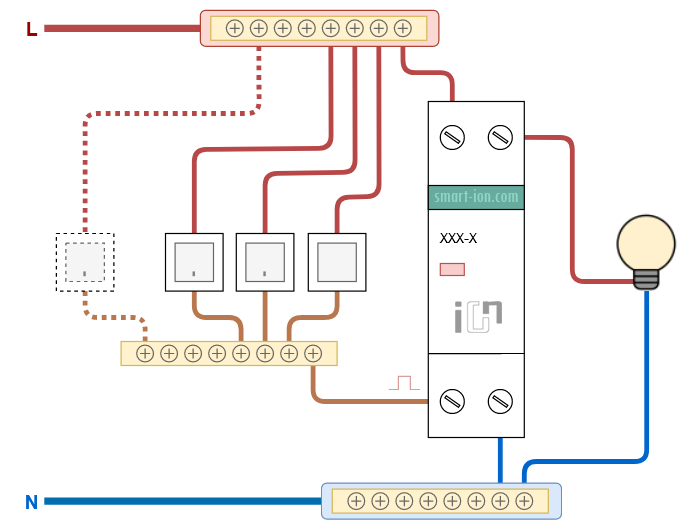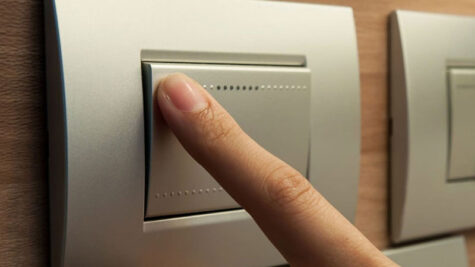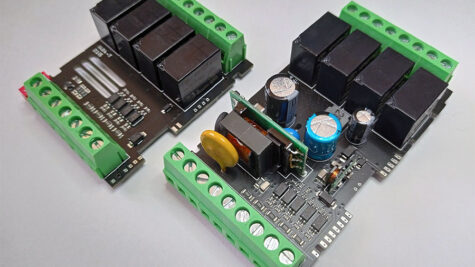Impulse relays to control lighting
In modern houses and apartments, lighting diagrams to control lights from two or more locations are increasingly being used.
In case one switch to control the lighting is not enough (e.g., when one needs to turn on the light at the beginning of a long hallway and turn it off when at the end), this can be achieved by means of a 2-way switch (SPDT, in the US this is named a 3-way switch).
However, in case more locations to control lights are required, it is difficult to run cabling to 2-way switches (SPDT type, in the US it is named 3-way switch) and crossover switches (DPDT type, in the US it is named 4-way switch).

In this case it is much easier to use impulse relays.
Wiring diagram for an impulse relay
Every lighting line has to be equipped with an independent impulse relay. The control circuit uses conventional non-locking push buttons (known as tactile switches), which are installed in parallel.

Impulse relays can control both a single lamp and a group of lights. The main thing is the overall switching current should not exceed the permissible current for relay terminals (normally this is 10-16A). Additionally, you should consider the inrush current of electrical appliances.
Impulse relay types
Impulse relays can be divided into two types: electromechanical (mechanism operates the device) and electronic (a device is operated by a PCB equipped with a controller).
Electromechanical impulse relays are reliable and can withstand high electric mains voltages. The cons here include loud clicking noises when switching and a lack of additional functions: they have only one function – to turn lights on or off when the switch is pushed.
Electronic impulse relays switch loads much quieter and have more functions (they can perform several functions). For instance, they can be equipped with timers, automatically switching the current off after a set period.
Pros of impulse relays
When using an impulse relay, you do not have to deal with complex circuit diagrams, mess around with 2-way and crossover switches, lay triple- or four-core cables, or waste time resolving other issues that crop up when developing a conventional diagram to control lights from different locations.
To control the lights using crossover switches all the wiring (cables) must have the appropriate cross-section for the actual load, as opposed to connecting the switches to an impulse relay, when it is permissible to use a minimal cross-section cable. As a result, when installing the device you benefit from significant cost savings on the materials, despite the fact that when installing impulse relays, star wiring (also known as “boxless”) is required.
Centralized switching
Unlike a classical master switch connection diagram using a conventional relay (contactor), a centralized switching diagram with impulse relays retains the ability to locally control all the electrical appliances in a premises after the “turn everything off” button is turned off – if somebody is still at home (e.g., somebody is still asleep when you’re leaving early in the morning), they can still turn any appliance on or off.
With this in mind, some manufacturers produce specialized impulse relays with a centralized control function, whilst others offer auxiliary modules installed alongside conventional impulse relays. However, if you want to centrally control more than just one lighting point, but also group them together (e.g., centralized lighting control in rooms on each floor plus overall centralized lighting control at the building entrance), you simply have to install auxiliary modules.
Two buttons – “turn everything off” and “turn everything on” – are connected to such specialized auxiliary modules. However, installing two additional buttons at the entrance is not always convenient, so it is more common to install just the one – “turn everything off”. Also, the number of impulse relays in a group (or the number of groups) is the same as the number of auxiliary modules to be installed if you want to have a centralized switching option.

Centralized switching in groups with a central switch:
• Every relay is controlled by a local switch (A, B, C and D).
• Every group is centrally controlled (1 abd 2).
• Main control switch (W) controls groups.
This arrangement is not very convenient – it greatly increases the complexity of installation work and adds to costs. We therefore examined all the cons listed above and developed a device that not only makes installation much easier, but has wide variety of customization options. And its price is significantly lower than that of a impulse relay set with auxiliary modules – since our ION CS-8 Central switch is capable of replacing 8 (eight) impulse relays with auxiliary modules, which is usually enough to comfortably control the lighting in a small flat. Also, it occupies only 3 standard din-units in a switchboard.
Auxiliary functions
The ION CS-8 Central switch can not only control a group of lighting points, but also separate subgroups. Turning off the lights on the whole floor of a building is not only convenient, but also saves energy.
The ION CS-8 The ION CS-8 also has built-in adjustable off-delay timers and on-state limits. It also distinguishes between short and long switch presses, giving you control over different loads with one switch and much more… Want to learn more? Go to our interactive online demo and try out our smart lighting control system.

More to read





FAQ
-
What is an impulse relay?
An impulse relay is a switching device designed to control electricity consumers. It works as follows: every time the switch is pressed, the built-in terminal of the relay changes its state – e.g., from switched on to switched off, etc.
With impulse relays you can organize lighting control from various locations. With these relays you get small current consumption during switching and no current consumption after switching
-
What types of impulse relays are there?
There two types of impulse relay:
- Electromechanical
- Electronic
The difference is in the switching method: in an electromechanical impulse relay, a mechanism operates the device, whereas in an electronic relay, a PCB is used with a microcontroller.
-
What is an impulse switch?
An impulse switch is a conventional tactile switch (non-locking), connected to an impulse relay. An impulse switch is used to control lights from different locations – large rooms, staircases, long hallways (turning on when entering and off when leaving).
